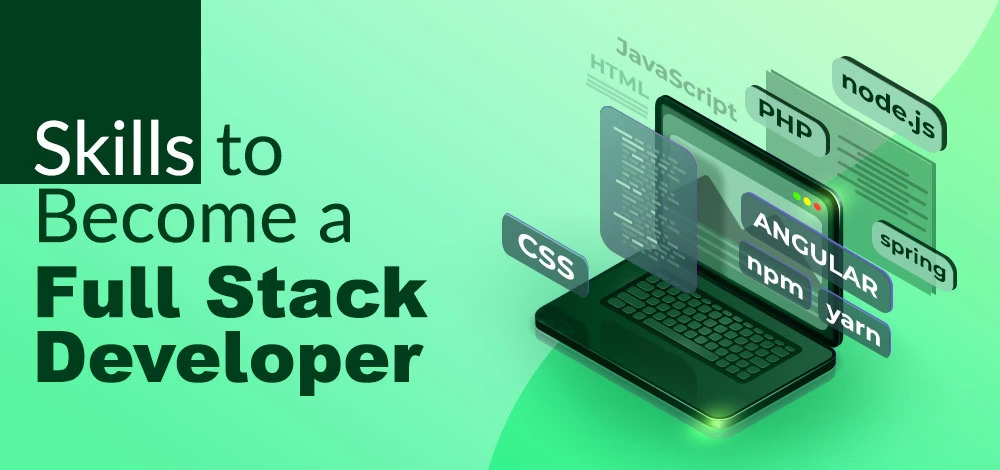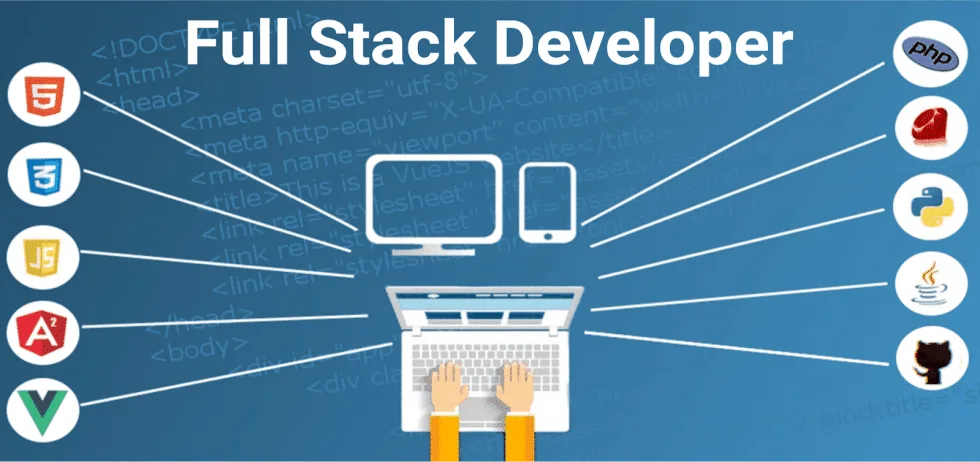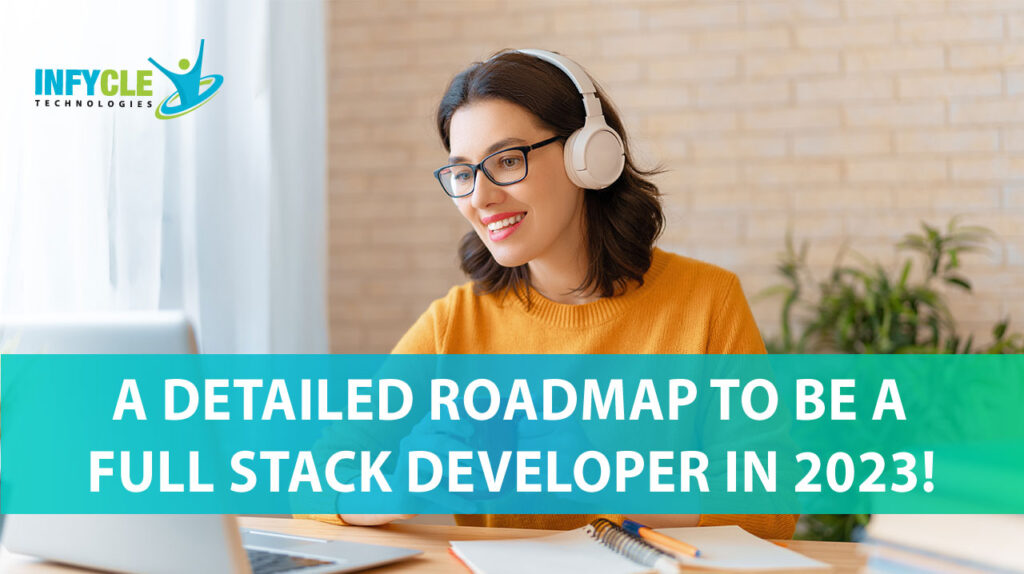A Detailed Roadmap to be a Full Stack Developer in 2024!
Building websites is no longer the domain of just front-end developers. To create a complete user experience, a detailed roadmap to be a full-stack developer is required. But what exactly is a full-stack developer?
In short, a full-stack developer can work on both the front and back ends of a website. They’re comfortable with HTML, CSS, and JavaScript on the front end, as well as PHP, Ruby on Rails, and Node.js on the back end.
U.S. Bureau of Labor Statistics has reported that Full Stack Development jobs will increase by 15% by 2024.
A full stack developer is an asset to any team because they provide a broad skillset and can handle any task that comes their way. If you’re interested in becoming a full-stack developer, read on for a detailed roadmap of what you need to do.
What is a Full Stack Developer?
A full-stack developer is a web developer who can work on both the front-end and back-end of a website. A full-stack developer can develop a website from start to finish. They can code in multiple programming languages, such as HTML, CSS, and JavaScript.
Most full-stack developers strongly understand server-side technologies, such as PHP, Ruby on Rails, and Node.js. They also have experience with databases such as MySQL, MongoDB, and Cassandra. In addition to their technical skills, full-stack developers also have good communication skills and are able to work well in a team environment.
What Skills are Required to be a Full Stack Developer?
In order to be a full-stack developer, one must have a wide range of skills. They must be able to work with different types of technologies and understand how they all work together. Additionally, full-stack developers must be able to code in multiple programming languages and have a strong understanding of database systems and web servers.

What are the Different Types of Full Stack Developers?
There are three main types of full-stack developers:
1. Front-end developers: These developers focus on the user interface and experience of a website or application. They use HTML, CSS, and JavaScript to build the front end of a web or mobile application.
2. Back-end developers: These developers focus on the server side of a web or mobile application. They use languages like PHP, Ruby on Rails, and Node.js to build the back end of a web or mobile application.
3. DevOps engineers: These engineers focus on the infrastructure and automation of a web or mobile application. They use tools like Puppet, Chef, and Ansible to manage the infrastructure of a web or mobile application.
How To Become A Full-Stack Developer?
In order to become a full-stack developer, one must first understand what a full-stack developer is. A full-stack developer is someone who can develop both the front-end and back-end of a website or application. This means they can code in multiple programming languages and have a deep understanding of how web applications work.
The first step to becoming a full-stack developer is to learn the basics of HTML, CSS, and JavaScript. These are the three leading technologies used to build websites and web applications. Once you have a solid understanding of these technologies, you can begin learning more specific technologies that are used for back-end development, such as PHP, Ruby on Rails, and Node.js.
Having a solid understanding of server administration and database management is also essential. This will come in handy when working on larger projects requiring you to deploy and manage servers. Additionally, having this knowledge will enable you to better troubleshoot issues that may arise during development.
Last but not least, it is crucial to constantly learn new things and keep up with the latest trends in web development. Technology is constantly evolving, so it’s essential to stay up-to-date with the latest advancements. By doing so, you’ll be able to provide your clients with the best possible solutions utilizing the latest technologies available.
What Is The Future Of Full Stack Development?
The future of full-stack development is in demand. Enterprises are searching for developers who can work with different types of technologies and have a broad range of skills. In order to keep up with the demand, developers need to continuously learn new skills and keep up-to-date with the latest trends.
Full-stack developers can use many different tools and frameworks to build applications. The most popular language for full-stack development is JavaScript. However, there are many other languages that can be used, such as PHP, Python, Ruby on Rails, and Java. Each language has its own set of benefits and drawbacks.

When choosing a language or framework, developers should consider the type of application they want to build, the programming paradigms they prefer, and the level of support they need. There is no single language or framework that is perfect for all applications. Developers should experiment with different languages and frameworks to find the ones that best fit their needs.
The future of full-stack development is bright. With the right skill set, developers can build almost any application imaginable. By staying up-to-date with the latest trends and technologies, developers can ensure that they will always be in demand.
Things To Learn
If you’re a full-stack developer, it always helps to have a roadmap for what you should learn. That way, you won’t feel confused or waste time. Some of the important things are listed below:
1. Choosing A Tech Stack
As a full-stack developer, you will need to choose a technology stack that you are comfortable working with. This will include choosing a programming language, web framework, database, and other tools. There are many different options to choose from, so it is important to do your research and select the right tools.
2. Backend Development
Once you have chosen your tech stack, you will need to learn how to develop the backend of your applications. This includes learning how to create server-side code and databases. You will also need to learn how to deploy your applications.
3. Frontend Development
In addition to backend development, you will also need to learn frontend development. This includes learning HTML, CSS, and JavaScript. You will also need to learn about frameworks such as AngularJS or ReactJS.
4. Database Development
Database development is another critical skill for full-stack developers. You will need to learn how to design and implement databases using MySQL, MongoDB, or another database technology. You should also be familiar with data modeling and query optimization techniques.
5. Version Control
Version control is an essential tool for any developer, but it is especially important for full-stack developers who are working on large projects with multiple team members. Git is the most popular version control system today, and it is important to know how to use it effectively.
Conclusion
We hope this roadmap has given you a better understanding of what it takes to become a full-stack developer. While the road ahead may seem daunting, remember that there are plenty of resources and people who can help you along the way and Infycle lends you a hand with an excellent Full Stack Developer Course in Chennai along with placement support to achieve your career goals. With Infycle, you’ll be well on your way to becoming a full-stack developer in 2024!





